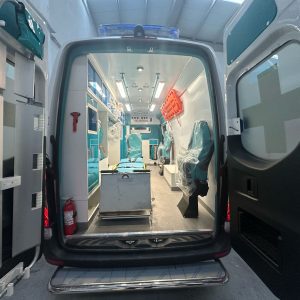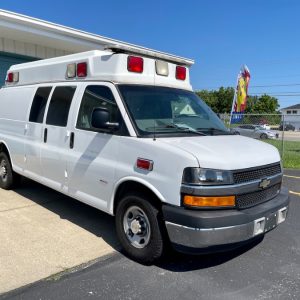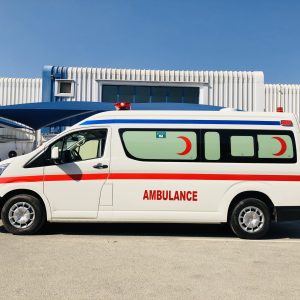Toyota Land Cruiser Ambulance; has a long history of being adapted for use as an ambulance and medical transport vehicle. Toyota first began producing the Land Cruiser line of 4WD vehicles in 1951. Known for their durability and off-road capabilities, Land Cruisers quickly became popular for use in remote and rugged areas.
In the 1960s, Land Cruisers began to be converted into ambulances to serve in developing countries and areas without extensive road infrastructure. Their sturdy chassis, high ground clearance, and four-wheel drive made them well-suited for reaching patients and transporting them over rough terrain. Global relief organizations like the Red Cross and Doctors Without Borders commissioned custom Land Cruiser ambulances to deploy to disaster zones and conflict areas worldwide.
Today, Toyota Land Cruiser ambulances continue to provide reliable medical transportation in parts of Africa, Asia, South America, and the Middle East. While meeting local specifications, they retain the off-road competence and endurance that has made the Land Cruiser a trusted platform for humanitarian and emergency medical services.
Toyota Land Cruiser Ambulance Conversion
Toyota Land Cruiser ambulances are typically converted by third party companies that specialize in outfitting vehicles for emergency medical services. Toyota manufactures and sells the base Land Cruiser models, then ambulance conversion companies purchase the vehicles and customize them to meet the needs of ambulance operators.
Some of the major ambulance conversion companies that outfit Toyota Land Cruisers include:
- AEV Ambulances (United States)
- WAS Vehicle Conversion (United Kingdom)
- Crestline Coach (Canada)
- Toyota Auto Body Co. (Japan)
- Wastafel (Australia)
These companies follow local regulations and standards for ambulance vehicles in the markets they serve. They install emergency lighting, sirens, stretchers, medical cabinets and equipment, communications systems, and other specialized gear to transform a standard Land Cruiser into a fully-functional ambulance.
The conversion companies work closely with local ambulance services and manufacturers to design optimal layouts and features for the rear patient cabin. They utilize the Land Cruiser’s off-road durability and reliability as a rugged base for ambulance conversions deployed around the world in all conditions.
Toyota Land Cruiser Ambulance Body and Interior
The Toyota Land Cruiser ambulance conversion features a spacious interior layout designed for medical transport. The rear compartment houses the main patient area, optimized for accessibility and functionality.
The floor is flat and open with anchor points to secure a cot or stretcher. There is ample headroom to accommodate patients sitting up on the cot if needed. Storage cabinets, hooks, and compartments line the walls to organize medical supplies and equipment.
The side doors open wide for easy loading and unloading of patients on stretchers. There are also rear lift gates available for bariatric patients or power cots. Inside, the cabin is stripped of unnecessary seats and fixtures to maximize space.
Various seating configurations can be installed such as sideways facing bench seats with seatbelts to transport multiple patients or EMTs. The driver cabin is separate from the patient area by a partition with a sliding window for communication.
The interior uses durable, easy to clean materials that can withstand heavy use and meets required safety standards. The layout maximizes accessibility, storage, and functionality to serve as a reliable ambulance for medical transport.
Toyota Land Cruiser Ambulance Medical Equipment
Toyota Land Cruiser ambulances are typically outfitted with essential medical equipment to administer emergency care and transport patients safely. Some of the key medical equipment installed includes:
- Stretcher – An adjustable stretcher or gurney is secured in the back to safely transport patients lying down. These are designed for easy loading and unloading of patients.
- Defibrillator – An automated external defibrillator (AED) is standard to revive patients in cardiac arrest by delivering electric shocks. Both manual and automated units may be installed.
- Oxygen Delivery System – This includes oxygen cylinders, regulators, and masks/cannulas to administer supplemental oxygen when needed. Flow meters allow dosage control.
- Suction Unit – A powered suction pump removes bodily fluids like vomit, blood, or mucus. Tubing, a collection bottle, and suction catheters provide controlled suction.
- Monitoring Equipment – Vital signs monitors track blood pressure, pulse oximetry, respiratory rate, temperature, ECG, etc. Some units transmit data remotely.
- IV Holders – Mounted hooks and poles to hang IV fluid bags and infusion pumps to administer medications/fluids.
- Cabinets & Storage – Cabinets, drawers, and compartments organize medical supplies and equipment conveniently and securely. Interior is customized.
Patient care and transportation necessitate this specialized medical equipment. Toyota Land Cruiser ambulances can be outfitted per regional requirements and protocols. The spacious interior can accommodate most essential equipment for emergency medical services.
Toyota Land Cruiser Ambulance Off-Road Capabilities
The Toyota Land Cruiser ambulance is renowned for its exceptional off-road performance and go-anywhere capability. This makes it an ideal choice for reaching patients in remote, rugged areas with poor road infrastructure.
The Land Cruiser utilizes a body-on-frame construction, with a rigid ladder frame paired with a flexible body. This allows it to handle punishing terrain without compromising passenger safety. It has high ground clearance, with up to 9.6 inches under the front axle. This enables the Land Cruiser ambulance to traverse rocks, deep ruts, steep inclines, and other obstacles.
Its permanent four-wheel drive system with a two-speed transfer case provides excellent traction on slippery, uneven surfaces. The Land Cruiser can lock the center differential for maximal grip when conditions are poor. It also has a low range gear for crawling slowly over difficult terrain without stalling.
Advanced traction control, electronic brakeforce distribution, and an anti-lock braking system give the driver more control when navigating precarious off-road conditions. These systems help to prevent wheel slip and loss of control in low traction situations.
With its off-road oriented suspension system, high approach/departure angles, and skid plates shielding vulnerable components, the Land Cruiser ambulance can handle punishing trails, deep water crossings, steep grades, and other hazards while transporting patients in safety and comfort. This makes it an ideal emergency response vehicle for rural areas and developing regions lacking infrastructure.
Toyota Land Cruiser Ambulance Reliability
The Toyota Land Cruiser has long been known for its legendary reliability and durability. This makes the Land Cruiser an ideal platform for ambulance conversions, as emergency medical services require vehicles that can handle frequent use in demanding conditions.
Land Cruisers are engineered to last, with robust construction and proven components that stand up to heavy daily use. The truck-based body-on-frame design provides strength and rigidity. The drivetrain components including the engine, transmission, differentials, and axles are overbuilt to handle challenging terrain and long service life.
Toyota’s reputation for reliability comes from stringent testing and quality control. Each new generation of Land Cruiser is put through punishing tests in extreme environments to ensure it lives up to the model’s heritage. The current 200 Series Land Cruiser has accumulated over 10 million test kilometers prior to production.
This reliability extends to the ambulance conversion as well. The medical module body and interior fitments are designed not to rattle or degrade even after years of vibration on rough roads. The electrical systems and medical equipment also need to perform reliably in emergency situations.
For emergency services, the Land Cruiser ambulance provides the durability to handle tough conditions as well as the dependability needed to respond whenever called upon. The vehicle’s proven reliability over decades of use makes it well suited to serve as a rugged and trustworthy ambulance platform.
Toyota Land Cruiser Ambulance Cost
The Toyota Land Cruiser ambulance conversion costs approximately $40,000-$60,000, depending on the level of customization and medical equipment included. This is on top of the base price of a new Toyota Land Cruiser, which starts around $85,000 for a basic model.
Overall, the Toyota Land Cruiser makes for an affordable ambulance platform compared to other purpose-built ambulance models which can cost $100,000 or more. The relatively low cost of acquisition makes the Land Cruiser attractive for many developing countries and aid organizations operating on limited budgets.
Ongoing maintenance and fuel costs are also reasonable for the Land Cruiser ambulance. It utilizes the same durable, low-maintenance drivetrain as the standard Land Cruiser. And while fuel economy is rated at only 13 mpg city/17 mpg highway, the Land Cruiser can readily handle lower grade fuels. This makes fuel costs manageable even in remote regions.
The Toyota Land Cruiser requires regular maintenance like any vehicle. But it is engineered for durability and ruggedness, even under difficult conditions. So major repairs are infrequent compared to other vehicles. The simple mechanics also make DIY repairs feasible where proper workshops are unavailable.
Overall, the total cost of ownership of a Toyota Land Cruiser ambulance is quite affordable. The robustness and reliability help minimize unexpected repairs over its lifetime. For cash-strapped regions needing a capable ambulance, the Land Cruiser presents an optimal balance of capabilities and operating costs.
Toyota Land Cruiser Ambulance Fuel Efficiency
The Toyota Land Cruiser ambulance has better fuel efficiency compared to other ambulances due to its rugged yet efficient engineering. While most ambulances in the United States are based on vans like the Ford Econoline or Dodge Sprinter, the Land Cruiser ambulance uses Toyota’s proven truck platform.
This gives the Land Cruiser ambulance a key advantage when operating in remote regions or over rough terrain. The standard 200 series Land Cruiser is rated for 13/18 mpg city/highway when equipped with the 4.5L V8 engine. Contrast this to a typical Ford Econoline-based ambulance that only achieves 10/14 mpg. The more efficient Toyota V8 allows the Land Cruiser ambulance to travel farther between fill-ups.
The strong fuel efficiency also makes the Land Cruiser a cost-effective choice over the long run. Considering that ambulances rack up high mileage in demanding conditions, the better mpg translates into thousands in fuel savings per year. This helps offset the higher initial purchase price of the Land Cruiser versus a standard van-based emergency vehicle.
Overall, the proven Toyota drivetrain gives the Land Cruiser ambulance an advantage for fuel efficiency. This aids operational range and reduces running costs, making it ideal for use in developing regions where fuel infrastructure is limited. The robust engineering provides efficiency without sacrificing power or off-road ability.
Notable Users
The Toyota Land Cruiser ambulance has been utilized by various major organizations that provide emergency medical services around the world.
One of the most prominent users is the International Red Cross and Red Crescent. For decades, the Red Cross has relied on the Land Cruiser ambulance to reach victims in need during disasters and crises. Its rugged dependability allows Red Cross personnel to access hard-to-reach areas affected by natural disasters like earthquakes, floods, and hurricanes. The Land Cruiser’s off-road capabilities enable the Red Cross to traverse rough, unpaved terrain to provide urgent medical care when it’s needed most.
Beyond the Red Cross, other major aid organizations and NGOs have adopted the Land Cruiser ambulance into their fleets. Groups like Doctors Without Borders, CARE International, and the United Nations High Commissioner for Refugees operate Land Cruiser ambulances in developing regions lacking infrastructure. Its durability and customizability allow these groups to outfit the Land Cruiser to handle the demands of makeshift dirt roads and transporting multiple patients when required.
Government entities also rely on the Land Cruiser ambulance for emergency services. State emergency management agencies, military medical units, and national park services use Land Cruiser ambulances for their reliability and off-road competence. The Land Cruiser ambulance has proven itself as an essential rescue vehicle for major organizations operating in harsh conditions.
Future Outlook
The Toyota Land Cruiser ambulance is likely to continue playing an important role in providing emergency medical services around the world, especially in remote and difficult to access areas.
A few reasons why Land Cruiser ambulances will remain relevant:
- Ruggedness and reliability – With its sturdy off-road capabilities, the Land Cruiser can reliably reach patients in places regular ambulances cannot. This makes it invaluable for rural communities and developing countries.
- Customizability – The spacious Land Cruiser can be fitted with various medical equipment to serve as a mobile clinic. This versatility allows it to be customized for different needs and budgets.
- Cost-effectiveness – Compared to purpose-built ambulances, the Toyota Land Cruiser provides an affordable ambulance solution. For organizations with limited funding, it offers vital emergency transportation.
- Aid work – International aid groups and NGOs often rely on Land Cruiser ambulances to provide medical services in disaster zones and remote areas lacking infrastructure.
- Military use – Militaries continue finding the Land Cruiser ambulance useful for medical evacuations in rough terrain or combat zones where normal ambulances can’t go.
While specialty ambulance manufacturers offer more advanced vehicles, the humble Toyota Land Cruiser is likely to remain a workhorse for emergency medical services requiring ruggedness and affordability. Its proven off-road capability and durability ensure this custom-built ambulance will continue serving where needed most.













